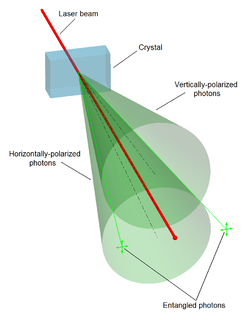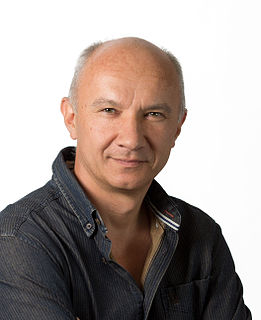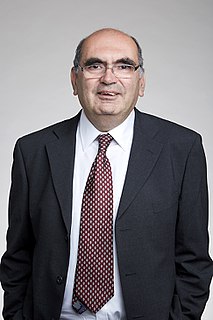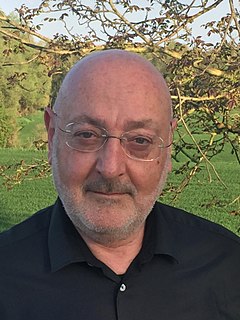
Quantum entanglement is a physical phenomenon that occurs when a group of particles are generated, interact, or share spatial proximity in a way such that the quantum state of each particle of the group cannot be described independently of the state of the others, including when the particles are separated by a large distance. The topic of quantum entanglement is at the heart of the disparity between classical and quantum physics: entanglement is a primary feature of quantum mechanics lacking in classical mechanics.
A Bell test, also known as Bell inequality test or Bell experiment, is a real-world physics experiment designed to test the theory of quantum mechanics in relation to Albert Einstein's concept of local realism. The experiments test whether or not the real world satisfies local realism, which requires the presence of some additional local variables to explain the behavior of particles like photons and electrons. To date, all Bell tests have found that the hypothesis of local hidden variables is inconsistent with the way that physical systems behave.

Artur Konrad Ekert FRS is a Polish-British professor of quantum physics at the Mathematical Institute, University of Oxford, professorial fellow in quantum physics and cryptography at Merton College, Oxford, Lee Kong Chian Centennial Professor at the National University of Singapore and the founding director of the Centre for Quantum Technologies (CQT). His research interests extend over most aspects of information processing in quantum-mechanical systems, with a focus on quantum communication and quantum computation. He is best known as one of the pioneers of quantum cryptography.

In physics, topological order is a kind of order in the zero-temperature phase of matter. Macroscopically, topological order is defined and described by robust ground state degeneracy and quantized non-Abelian geometric phases of degenerate ground states. Microscopically, topological orders correspond to patterns of long-range quantum entanglement. States with different topological orders cannot change into each other without a phase transition.
Quantum cloning is a process that takes an arbitrary, unknown quantum state and makes an exact copy without altering the original state in any way. Quantum cloning is forbidden by the laws of quantum mechanics as shown by the no cloning theorem, which states that there is no operation for cloning any arbitrary state perfectly. In Dirac notation, the process of quantum cloning is described by:
In theoretical physics, quantum nonlocality refers to the phenomenon by which the measurement statistics of a multipartite quantum system do not admit an interpretation in terms of a local realistic theory. Quantum nonlocality has been experimentally verified under different physical assumptions. Any physical theory that aims at superseding or replacing quantum theory should account for such experiments and therefore must also be nonlocal in this sense; quantum nonlocality is a property of the universe that is independent of our description of nature.
Objective-collapse theories, also known as models of spontaneous wave function collapse or dynamical reduction models, were formulated as a response to the measurement problem in quantum mechanics, to explain why and how quantum measurements always give definite outcomes, not a superposition of them as predicted by the Schrödinger equation, and more generally how the classical world emerges from quantum theory. The fundamental idea is that the unitary evolution of the wave function describing the state of a quantum system is approximate. It works well for microscopic systems, but progressively loses its validity when the mass / complexity of the system increases.

In strong interaction physics, light front holography or light front holographic QCD is an approximate version of the theory of quantum chromodynamics (QCD) which results from mapping the gauge theory of QCD to a higher-dimensional anti-de Sitter space (AdS) inspired by the AdS/CFT correspondence proposed for string theory. This procedure makes it possible to find analytic solutions in situations where strong coupling occurs, improving predictions of the masses of hadrons and their internal structure revealed by high-energy accelerator experiments. The most widely used approach to finding approximate solutions to the QCD equations, lattice QCD, has had many successful applications; however, it is a numerical approach formulated in Euclidean space rather than physical Minkowski space-time.
Quantum cryptography is the science of exploiting quantum mechanical properties to perform cryptographic tasks. The best known example of quantum cryptography is quantum key distribution which offers an information-theoretically secure solution to the key exchange problem. The advantage of quantum cryptography lies in the fact that it allows the completion of various cryptographic tasks that are proven or conjectured to be impossible using only classical communication. For example, it is impossible to copy data encoded in a quantum state. If one attempts to read the encoded data, the quantum state will be changed due to wave function collapse. This could be used to detect eavesdropping in quantum key distribution.
Andrew G. White FAA is an Australian scientist and is currently Professor of Physics and a Vice-Chancellor's Senior Research Fellow at the University of Queensland. He is also Director of the University of Queensland Quantum technology Laboratory; Deputy-Director of the ARC Centre for Engineered Quantum systems, and a Program Manager in the ARC Centre for Quantum Computer and Communication Technology..
In quantum information theory, quantum discord is a measure of nonclassical correlations between two subsystems of a quantum system. It includes correlations that are due to quantum physical effects but do not necessarily involve quantum entanglement.
The noisy-storage model refers to a cryptographic model employed in quantum cryptography. It assumes that the quantum memory device of an attacker (adversary) trying to break the protocol is imperfect (noisy). The main goal of this model is to enable the secure implementation of two-party cryptographic primitives, such as bit commitment, oblivious transfer and secure identification.
Tim C. Ralph is an Australian physicist who specializes in the application of quantum optics to quantum information science and quantum computing. He is Professor in Physics at the University of Queensland, and Program Manager in the ARC Centre for Quantum Computer and Communication Technology. Ralph is known for developing continuous variable quantum cryptography and co-founder of measurement based computation with continuous variable optics. In 2012, Ralph was one of the scientists responsible for establishing quantum discord as a computational resource. As of 2012, Tim has 200 publications and over 4500 citations. He has co-authored "A guide to experiments in quantum optics". His publications include 23 in Physical Review Letters, 6 in the Nature suite of journals, as well as articles in Science and Reviews of Modern Physics.
Dynamical decoupling (DD) is an open-loop quantum control technique employed in quantum computing to suppress decoherence by taking advantage of rapid, time-dependent control modulation. In its simplest form, DD is implemented by periodic sequences of instantaneous control pulses, whose net effect is to approximately average the unwanted system-environment coupling to zero. Different schemes exist for designing DD protocols that use realistic bounded-strength control pulses, as well as for achieving high-order error suppression, and for making DD compatible with quantum gates. In spin systems in particular, commonly used protocols for dynamical decoupling include the Carr-Purcell and the Carr-Purcell-Meiboom-Gill schemes. They are based on the Hahn spin echo technique of applying periodic pulses to enable refocusing and hence extend the coherence times of qubits.

Sandu Popescu is a Romanian-British physicist working in the foundations of quantum mechanics and quantum information.
Continuous-variable (CV) quantum information is the area of quantum information science that makes use of physical observables, like the strength of an electromagnetic field, whose numerical values belong to continuous intervals. One primary application is quantum computing. In a sense, continuous-variable quantum computation is "analog", while quantum computation using qubits is "digital." In more technical terms, the former makes use of Hilbert spaces that are infinite-dimensional, while the Hilbert spaces for systems comprising collections of qubits are finite-dimensional. One motivation for studying continuous-variable quantum computation is to understand what resources are necessary to make quantum computers more powerful than classical ones.

Giacomo Mauro D'Ariano is an Italian quantum physicist. He is a professor of theoretical physics at the University of Pavia, where he is the leader of the QUIT group. He is a member of the Center of Photonic Communication and Computing at Northwestern University; a member of the Istituto Lombardo Accademia di Scienze e Lettere; and a member of the Foundational Questions Institute (FQXi).
Relativistic quantum cryptography is a sub-field of quantum cryptography, in which in addition to exploiting the principles of quantum physics, the no-superluminal signalling principle of relativity theory stating that information cannot travel faster than light is exploited too. Technically speaking, relativistic quantum cryptography is a sub-field of relativistic cryptography, in which cryptographic protocols exploit the no-superluminal signalling principle, independently of whether quantum properties are used or not. However, in practice, the term relativistic quantum cryptography is used for relativistic cryptography too.

Ivette Fuentes is a Professor of Mathematical Physics at the University of Nottingham and Professor of Theoretical Quantum Optics at the University of Vienna. Her work considers fundamental quantum mechanics, quantum optics and astrophysics. She is interested in how quantum information theory can make use of relativistic effects.
Barbara Kraus is an Austrian physicist specializing in quantum information, quantum entanglement, and quantum key distribution. She is a University Professor of Physics at the University of Innsbruck.







